Learn how to color white chocolate or confectionery coating (candy melts) to use to make homemade chocolate lollipops. It's so much fun and it's easy enough that even kids can make their own candy lollipops.
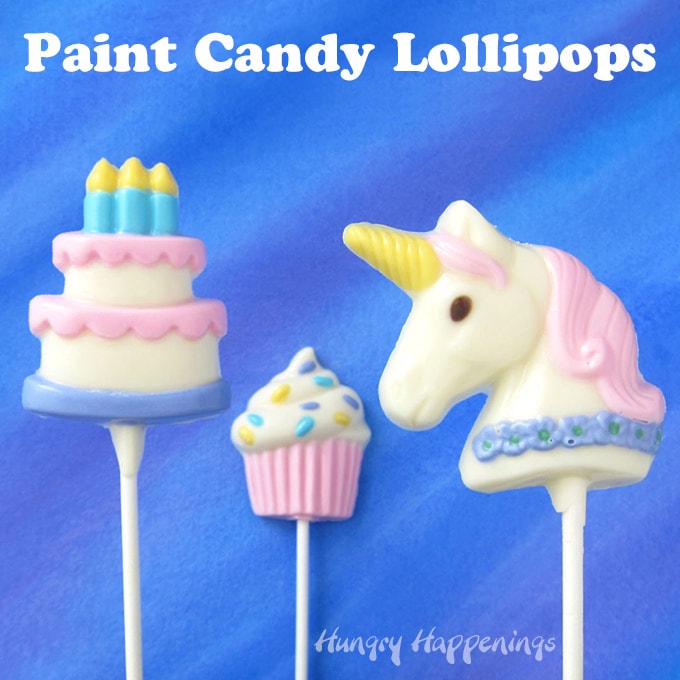
In this tutorial, I will show you how to paint colored white chocolate or confectionery coating into candy molds to create cute and colorful lollipops for any occasion.
This candy painting technique can also be used to create things like chocolate Easter bunnies and white chocolate lambs.
Before you start, you might want to check out my Chocolate Making Tips page. There you will find detailed information regarding the various types of chocolates and proper melting methods.
I'll give you some information in the tutorial below, but the tips page is a great place to start.
Ingredients
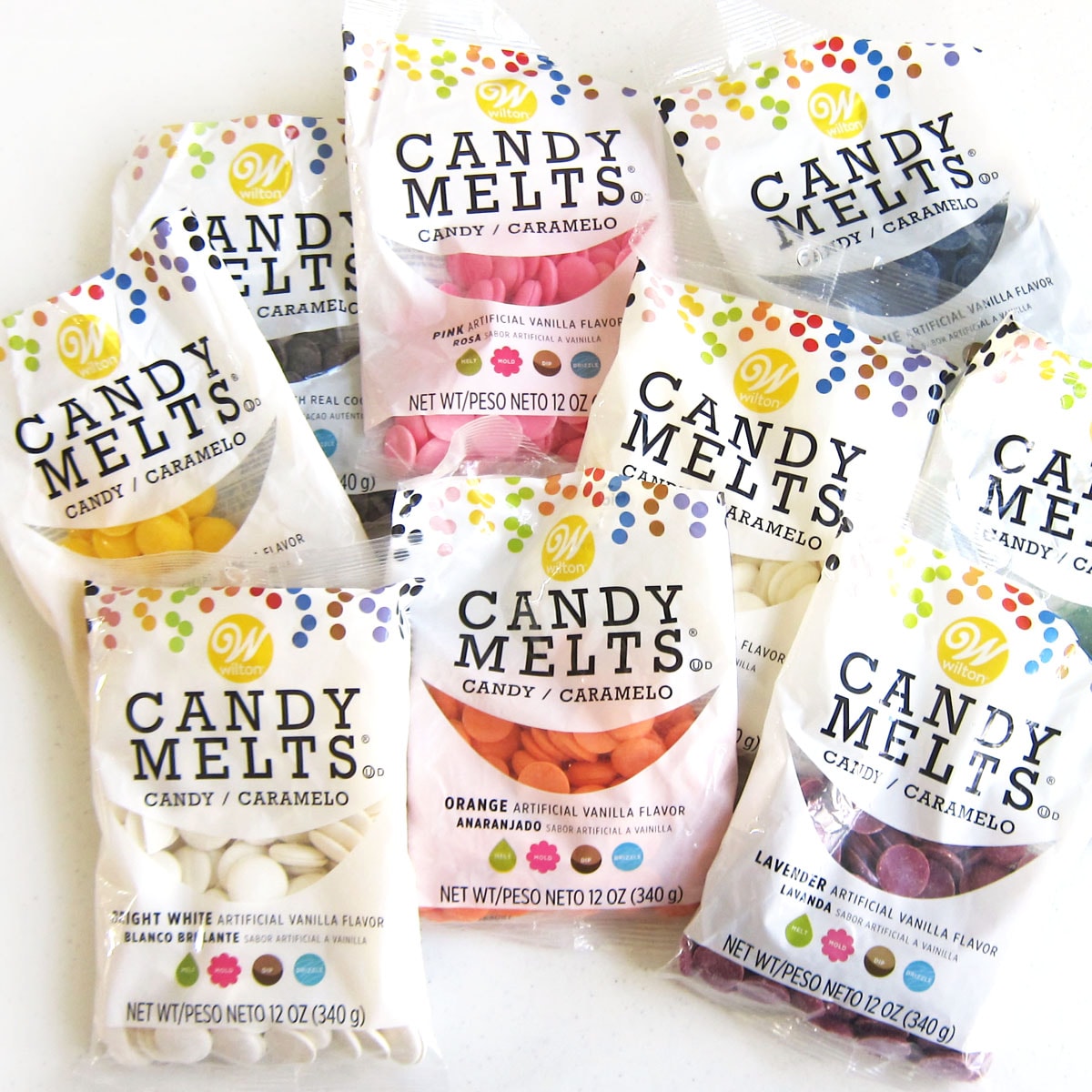
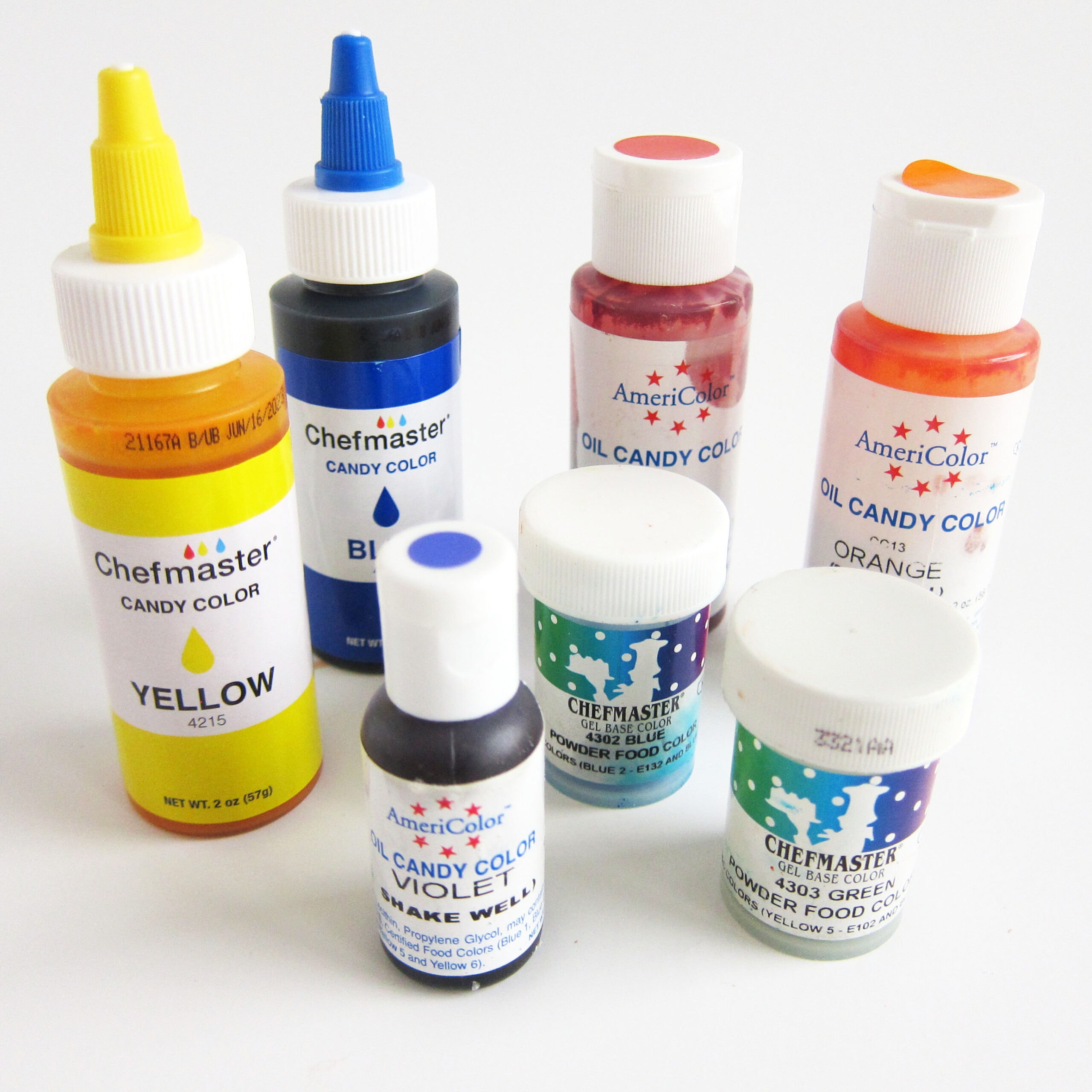
To make handpainted chocolate lollipops, you will need:
chocolate (pure or compound)
oil-based candy coloring (if needed)
Pure white chocolate contains cocoa butter and must be tempered (see my Chocolate Making Tips page for details on tempering.)
It has an off-white, yellowish, or cream-colored hue.
It must be colored with oil-based food coloring that is specifically made to color chocolate.
The challenge with using pure white chocolate is keeping small quantities in temper while you are painting your candy molds. If you are a home cook and are interested in making hand-painted chocolates, I suggest you use confectionery coatings instead.
Below I will show you an easy method to keep the candy coating melted all day long so you can make dozens of lollipops quickly and easily.
Compound chocolate is typically made with palm kernel oil instead of cocoa butter making it easy to melt.
They have many names including Candy Melts, Melting Chocolate Wafers, Almond Bark, and Candy Coating.
They are available in white, bright white, dark cocoa, light cocoa, and many colors including red, blue, yellow, orange, purple, and green.
Compound chocolate must be colored using oil-based food coloring designed specifically for chocolates.
There are several manufacturers that make white, light cocoa, dark cocoa, and colored candy coatings. which can be purchased from craft stores, candy & cake decorating shops, or online.
These colored candy wafers are available on Amazon.com (I earn a small commission on any sales from using the links below at no additional cost to you.)
 Wilton Candy Melts, 12-Ounc...Shop on Amazon
Wilton Candy Melts, 12-Ounc...Shop on Amazon  Merckens Coatings, Pink, 1 ...Shop on Amazon
Merckens Coatings, Pink, 1 ...Shop on Amazon  Yellow Vanilla Flavored Mel...Shop on Amazon
Yellow Vanilla Flavored Mel...Shop on Amazon  Strawberry Apeels: 25LBSShop on Amazon
Strawberry Apeels: 25LBSShop on Amazon  Clasens Coatings, RedShop on Amazon
Clasens Coatings, RedShop on Amazon
I often use Wilton Candy Melts because they are easy to find at JoAnn's, Michaels, and even Walmart, and they come in a rainbow of colors. When using white confectionery coating, I prefer the flavor of Peter's White Caps.
Before you can color your chocolate or candy coating you need to melt it. See the Chocolate Making Tips page for detailed instructions.
You must use oil-based candy coloring specifically formulated for chocolate or powdered candy coloring to color white chocolate.
Do not use liquid (water-based) food coloring or gel icing colorings. The water in these types of colorings will react to the chocolate causing it to seize up (harden or thicken).
You can find oil-based candy coloring at cake decorating shops, candy-making stores, some craft stores, and online.
I personally use Chefmaster Liquid Candy Coloring. The coloring is thin enough to squeeze out of the bottle in small droplets which is great when I'm coloring a small amount of candy.
You can find these brands of chocolate coloring on Amazon.com. (commission earned for sales).
 Wilton Candy Decorating Pri...Shop on Amazon
Wilton Candy Decorating Pri...Shop on Amazon  AmeriColor 2 oz Navy Blue O...Shop on Amazon
AmeriColor 2 oz Navy Blue O...Shop on Amazon  Chefmaster Liquid Candy Col...Shop on Amazon
Chefmaster Liquid Candy Col...Shop on Amazon  Americolor Powder Food Colo...Shop on Amazon
Americolor Powder Food Colo...Shop on Amazon  Wilton Garden Candy Color S...Shop on Amazon
Wilton Garden Candy Color S...Shop on Amazon
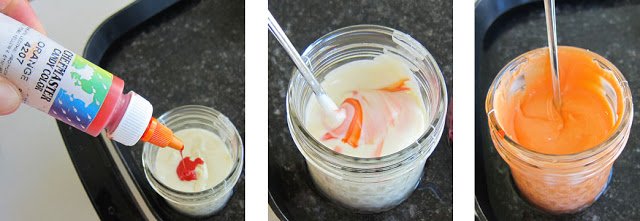
If you are using candy coloring in a squeeze bottle, squeeze in a small amount of coloring and stir well. Add more coloring if needed to achieve the desired shade.
If using powdered color, sprinkle some over top and stir in. Add more as needed.
If using candy coloring that comes in a jar, insert a toothpick into the coloring then insert that toothpick into your jar of white chocolate and stir. Then remove the toothpick and throw it away after its first use. If you put the candy-coated toothpick back into your jar of coloring you will contaminate the coloring.
Tips
- Off-white candy wafers will add a touch of yellow to your colored candy, so be sure to use bright white candy coating bright white to make cool colors like blue and purple.
- It is very difficult to color white candy melts to get a deep red or dark green, so I suggest buying them instead.
- Confectionery coating that is colored using bright pink or even lilac will fade over time. Don't ask me why this happens, but it does. I suggest purchasing colored pink candy wafers. They will hold their vibrant color and won't fade nearly as much.
- Black candy melts are not truly black. Sometimes they look gray, other times they look more blue. I suggest buying some black candy coloring to add if you want deep dark black candy.
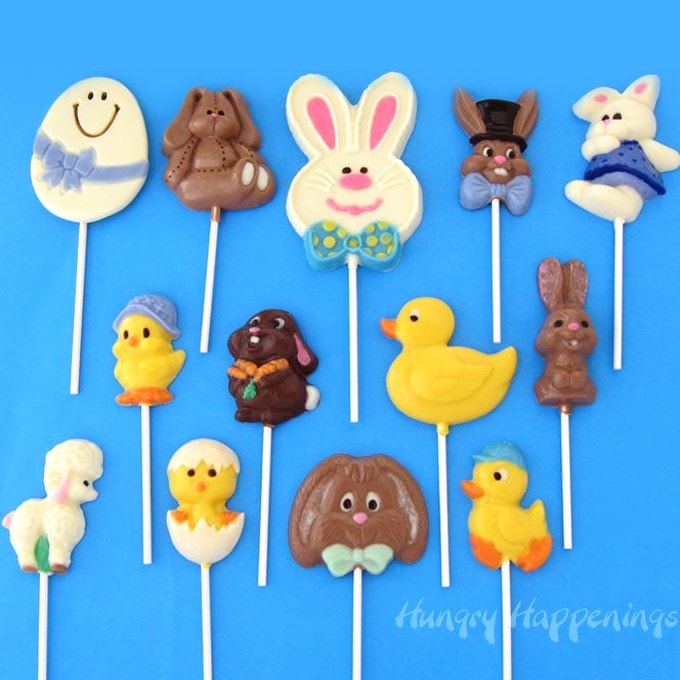
Supplies
You can melt your candy in small bowls, using a microwave, but I highly recommend using an electric skillet. I'll show you below how I use it to keep my candy coating melted all day.
- electric skillet*
- glass jars, coffee mugs, or drinking glasses
- paintbrushes (use new or food-use-only brushes, I recommend plastic handle brushes)
- candy molds
*I love using an electric skillet filled with water to keep my jars of candy melted all day. You can also use a crockpot, but the skillet has more room and the lower walls make it easier to access the jars of candy coating.
You can find these supplies on Amazon.
 Testors 20-Pack Economy Pai...Shop on Amazon
Testors 20-Pack Economy Pai...Shop on Amazon  Presto 06852 16-Inch Electr...Shop on Amazon
Presto 06852 16-Inch Electr...Shop on Amazon  Ball Pint Mason Jars, 16 oz...Shop on Amazon
Ball Pint Mason Jars, 16 oz...Shop on Amazon  Ball Half Pint (8 oz.) Regu...Shop on Amazon
Ball Half Pint (8 oz.) Regu...Shop on Amazon  Wilton Candy Melts Candy An...Shop on Amazon
Wilton Candy Melts Candy An...Shop on Amazon  Testors Paint Brush kitShop on Amazon
Testors Paint Brush kitShop on Amazon

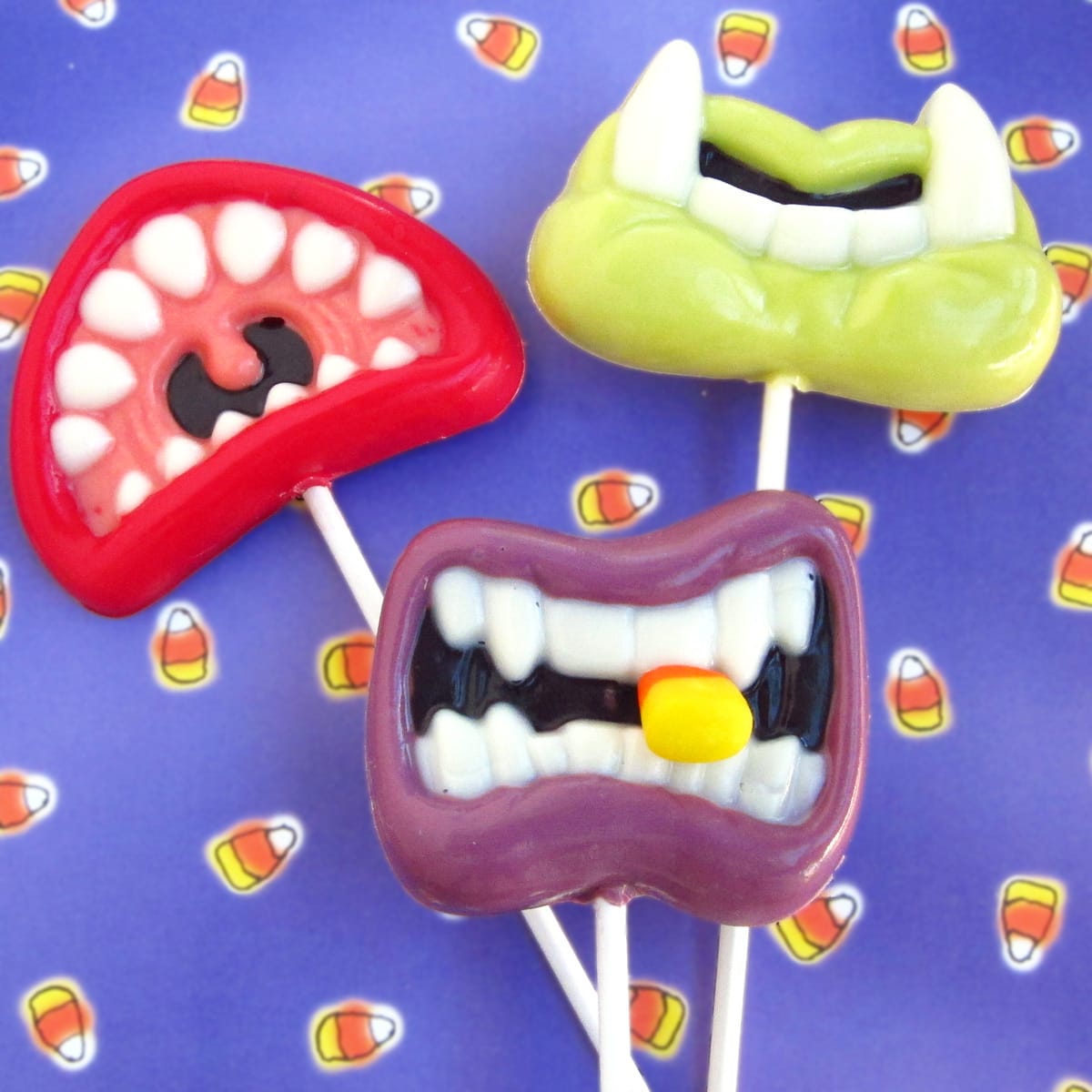
Lollipops can be made for any occasion like Easter, Halloween, Christmas, birthday parties, and more.
Below I will show you how to paint an Easter Bunny using a candy mold from a company that has sadly gone out of business.
There are lots of other candy molds to choose from on Amazon and other online retailers like Kerekes though. Here are just a few Easter designs.
 Cybrtrayd Life of the Party...Shop on Amazon
Cybrtrayd Life of the Party...Shop on Amazon  Carrot Chocolate Candy Mold...Shop on Amazon
Carrot Chocolate Candy Mold...Shop on Amazon  Candy Molds N More Easter B...Shop on Amazon
Candy Molds N More Easter B...Shop on Amazon  Easter Egg Face Pop Lollipo...Shop on Amazon
Easter Egg Face Pop Lollipo...Shop on Amazon  Wilton Lollipop Mold: Hoppy...Shop on Amazon
Wilton Lollipop Mold: Hoppy...Shop on Amazon
Melting Chocolate
Check out my Chocolate Making Tips page for instructions on melting chocolate using a microwave or the stovetop.
Below, I will show you how to melt compound chocolate using a water bath in an electric skillet. It is my favorite way to melt candy melts for a day of lollipop-making.
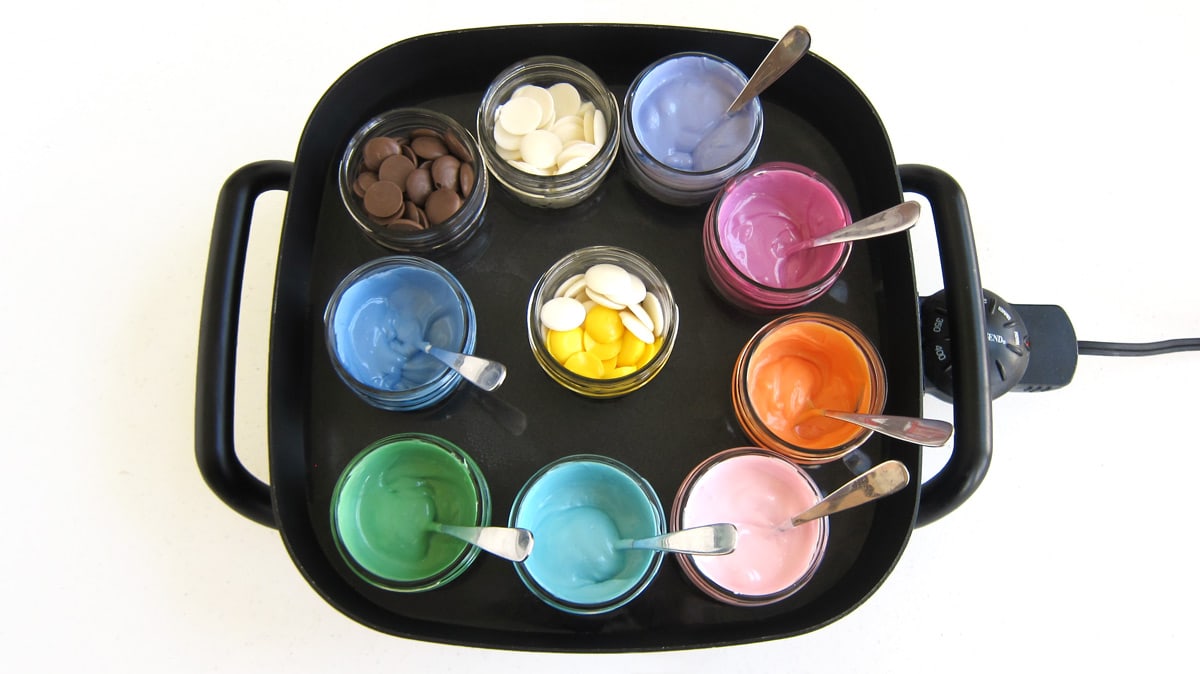
Fill an electric skillet with some hot water and set the temperature to "WARM" (or the lowest setting).
Fill glass jars, coffee mugs, or ramekins with the confectionery coating wafers.
Place the jars in the water-filled skillet. Make sure the water comes up about halfway on your shortest jar.
As the chocolate wafers heat up, stir them occasionally until they are completely melted. You can melt the candy melts in the microwave first then place the jars in the skillet if you'd like to speed things up.
Be sure to melt the chocolate using low temperatures if heating it in a double boiler or in a water bath in an electric skillet. If your chocolate gets too hot it will get too thick or can even burn and harden.
Do not allow even a single drop of water to fall into the chocolate. When water touches chocolate, it will cause it to seize (thicken and harden).
Tips
You can keep your candy coating melted all day using this method, just stir the coating throughout the day to keep the coating near the top of the jar from hardening.
Be sure to replenish the water, with more hot water, as it evaporates.
Most importantly, be careful that you don't spill water in the chocolate, or it will seize up and become too thick to use. If you pick up a jar to move it closer to you, put a towel under the jar as you move it, so drops of water don't end up in other jars of coating. If you do drop some water in a jar, scoop out the water. Do not stir it in.
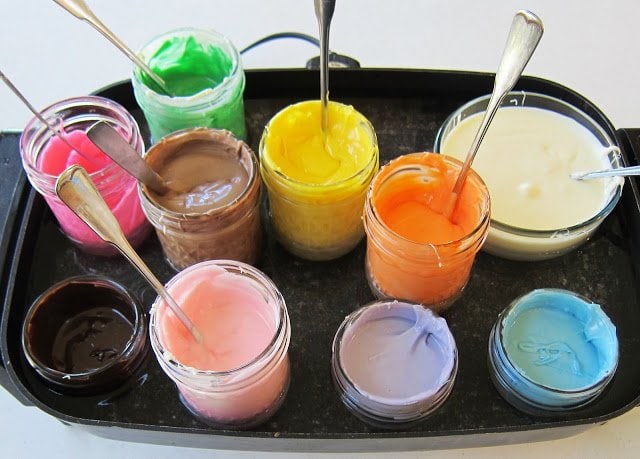
- Create all of the colors you want to use in your lollipops.
- For Easter, I like to use pastel colors for some of the pops and more vibrant colors for others.
- You can adjust colors while you are working by adding more coloring (for brighter colors)or by stirring in some white candy coating (for more pastel colors).
- If you are using colored candy melt wafers and you want to lighten the colors, just stir in some white.
- Get your candy molds and paintbrushes together and clean out your freezer, so you have some space to place the molds.
Before I show you the step-by-step process for painting candy molds, let's talk about a problem that you might encounter when making chocolate lollipops.
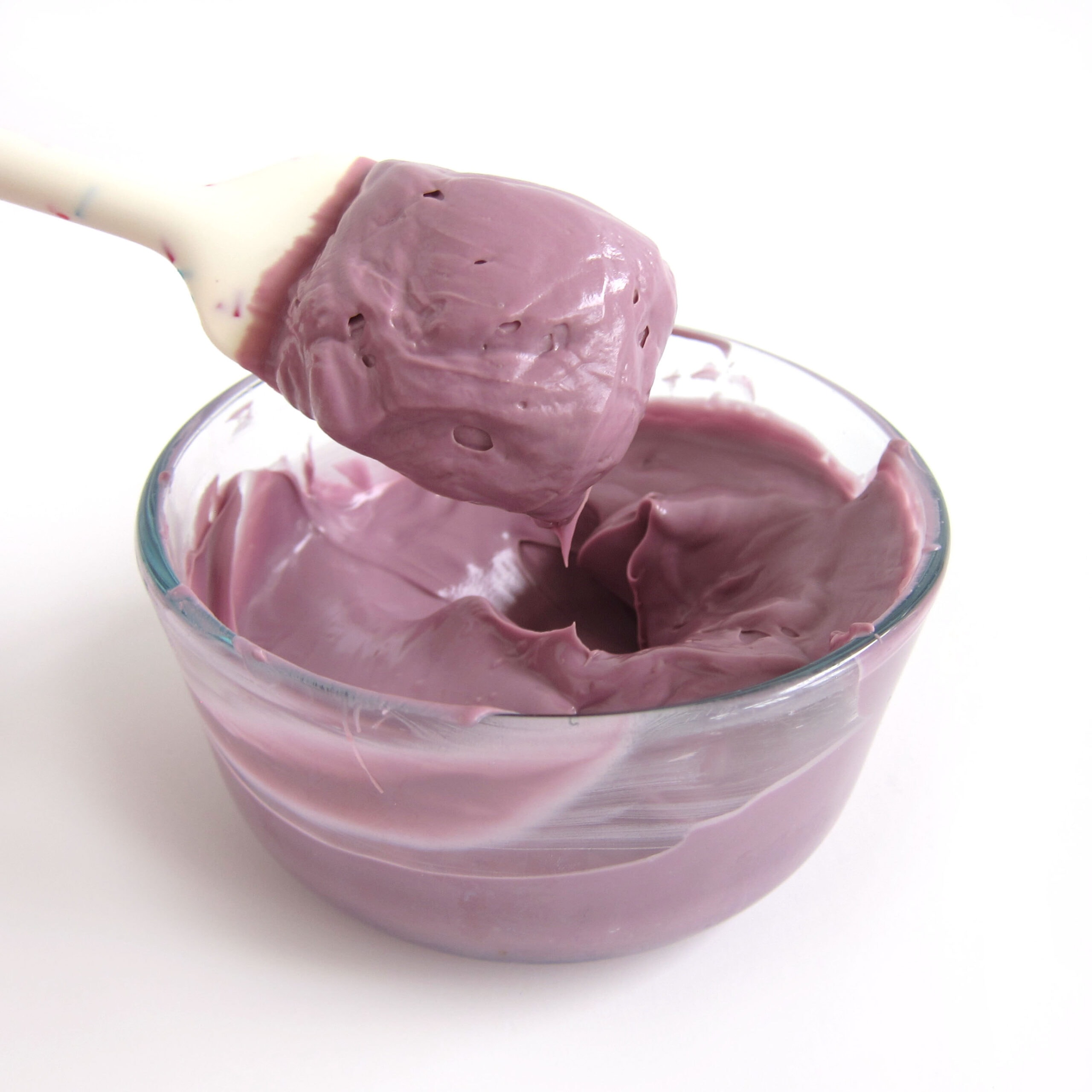
Thick Candy Melts
Wilton Candy Melts or any other type of compound chocolate can become too thick to work with. Don't worry, you can fix this problem.
Candy melts can become thick if they are exposed to drastic changes in temperature, are stored in direct sunlight, are past their expiration date, are heated at high temperatures, are exposed to water or condensation, or are colored using liquid or gel food coloring.
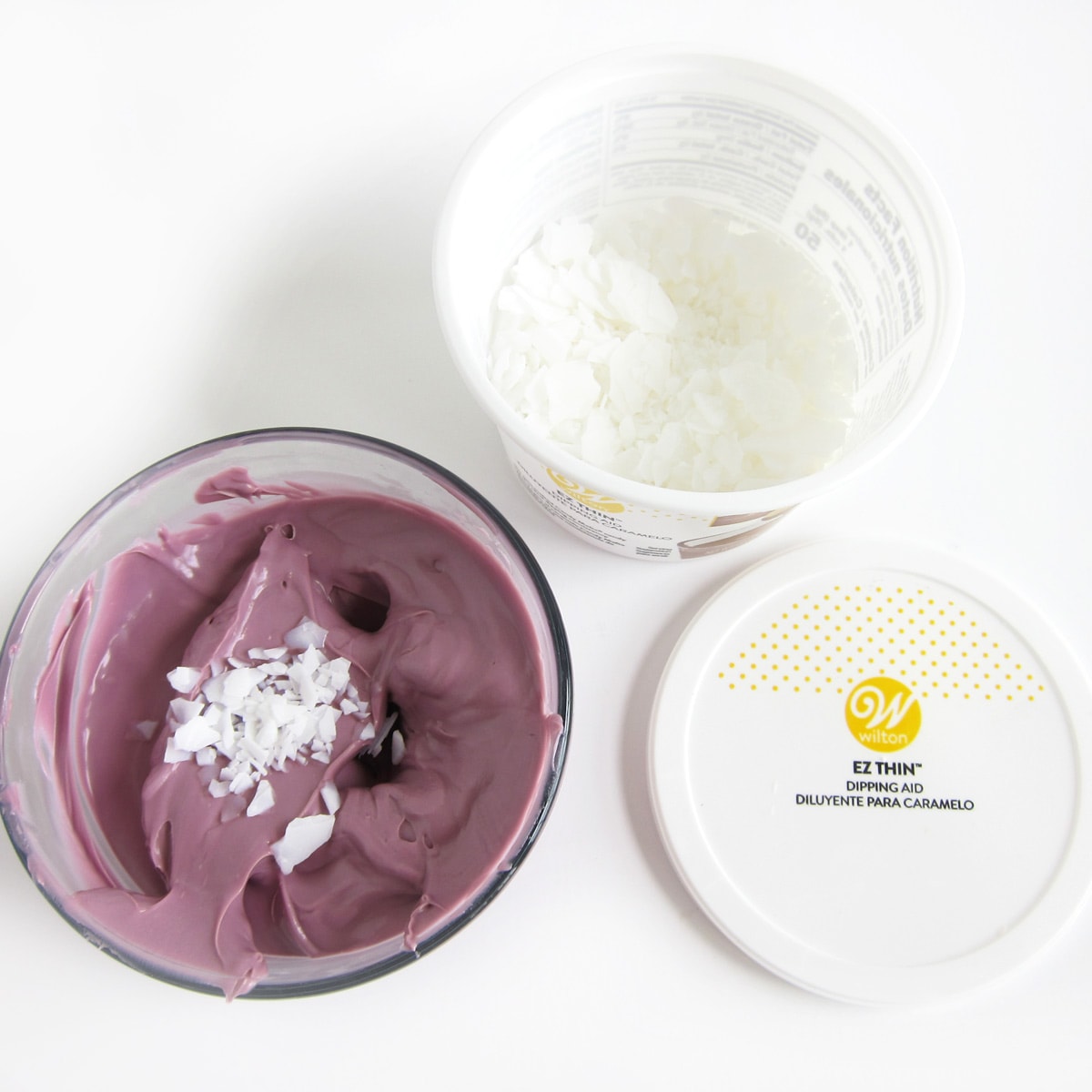
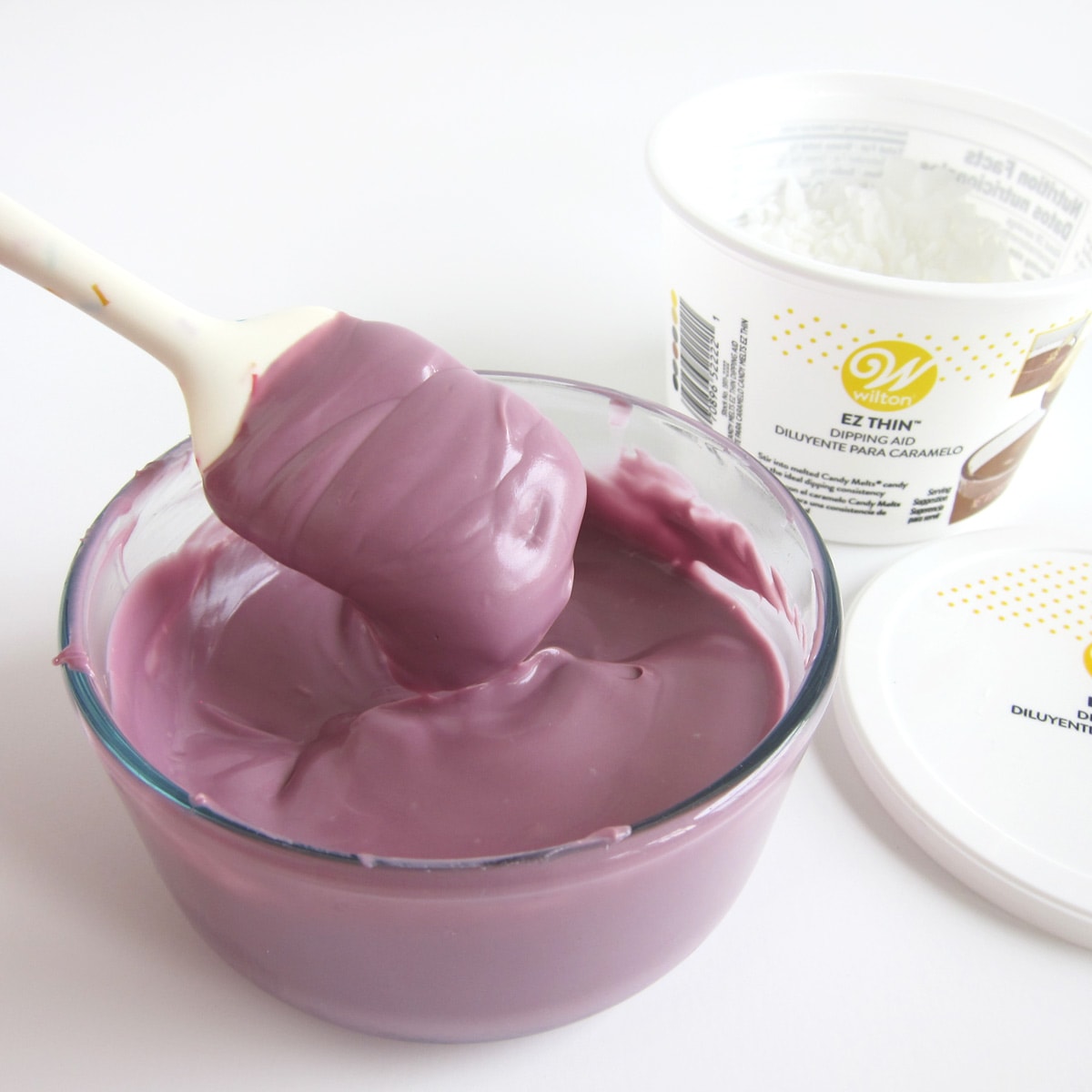
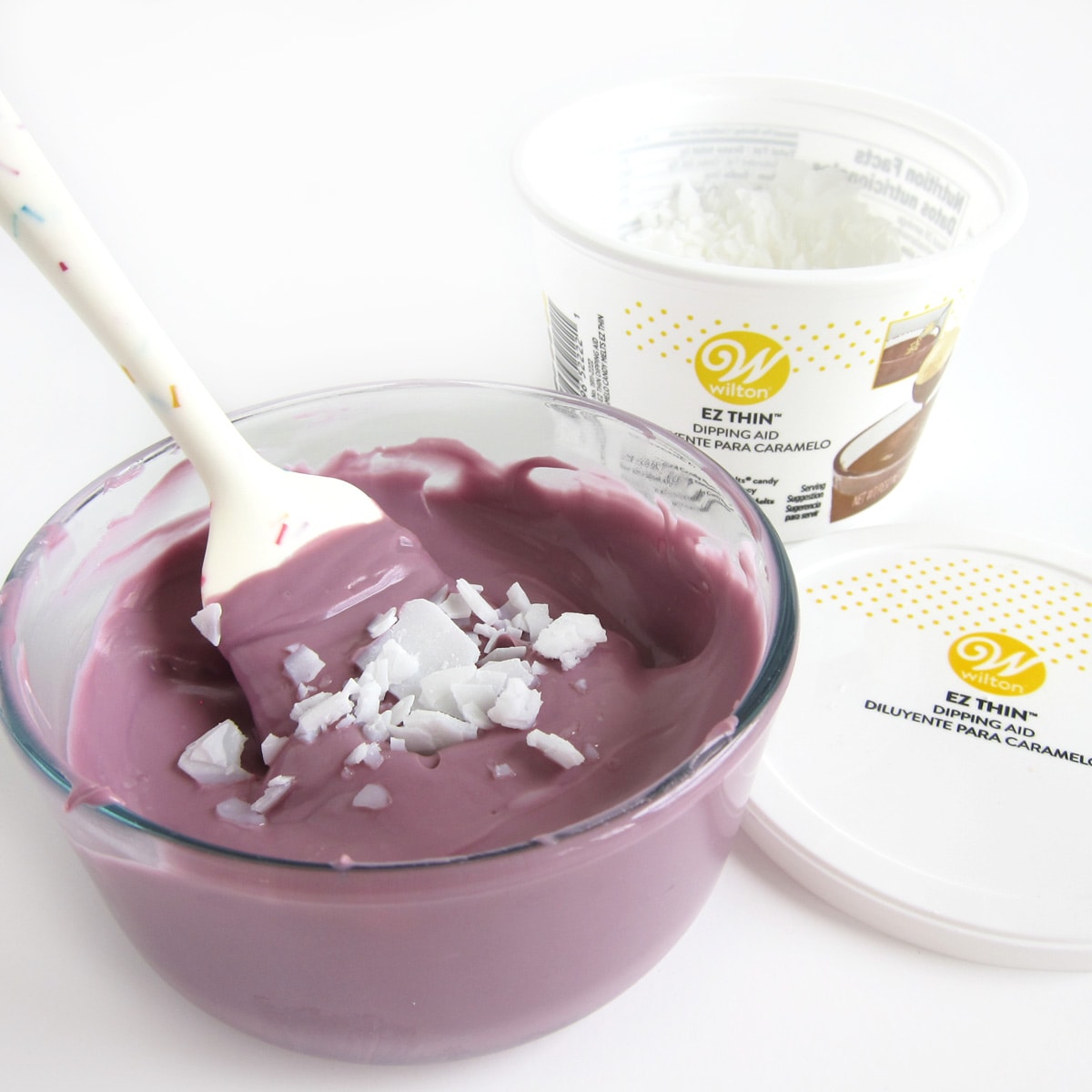
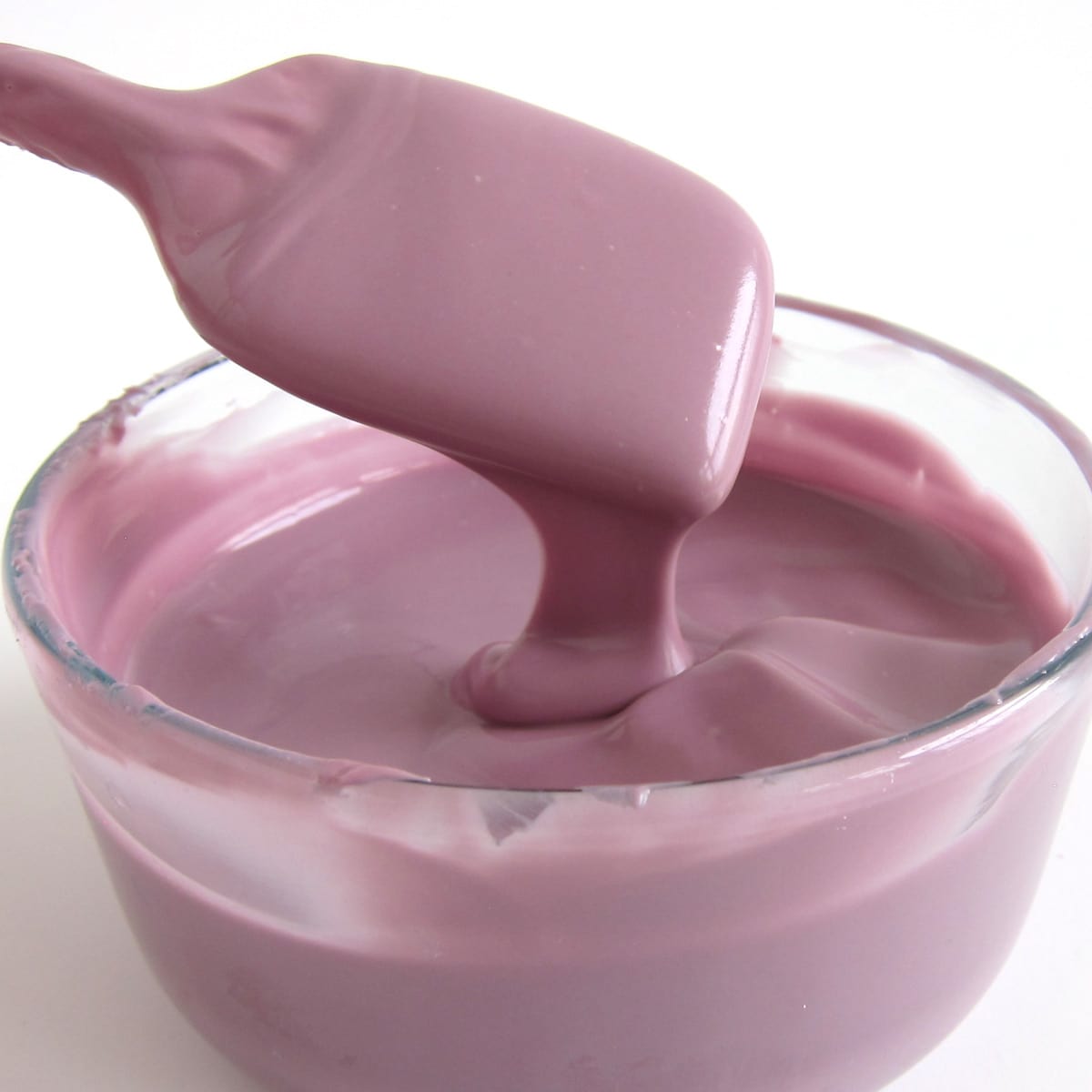
Add a small pinch of Paramount Crystals or Wilton Candy Melts EZ Thin to the thick candy coating, and stir until melted. Continue to add small amounts of the flakes, stirring after each addition, until the candy melts are thin enough to pour.
Paramount Crystals are flakes of solid palm kernel oil (the fat that is used to make the candy melts). Paramount Crystals will work to thin out thick candy melts but will also allow your candy to harden properly.
These flakes of fat will melt into warm candy melts. If they won't melt after stirring, you may need to reheat the chocolate to warm it up.
In a pinch, you can use a small amount of vegetable oil to thin out your candy melts, but if you add too much, your candy will never harden properly. Vegetable oil is liquid at room temperature so an excess amount mixed into the candy will cause the candy to be soft.
Shortening is a better option to thin out thick candy melts as it is solid at room temperature. Just note that it can change the flavor of your candy melts if you add too much.
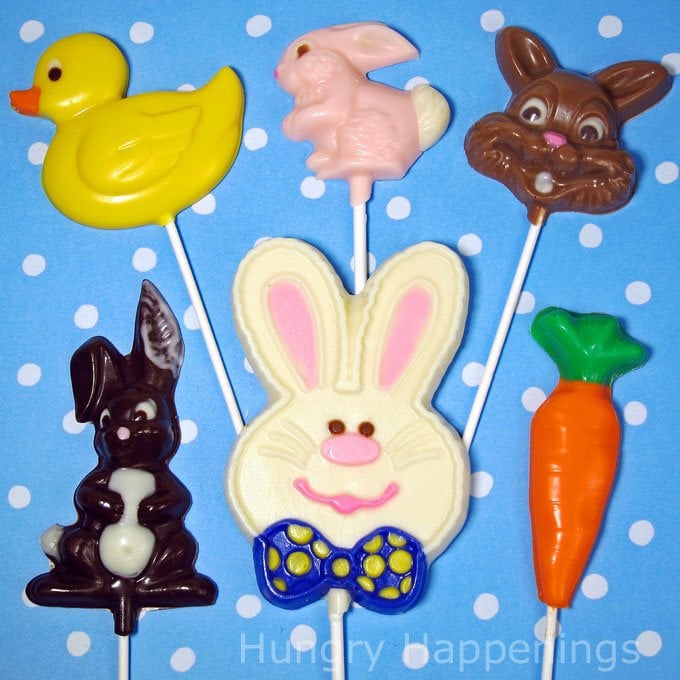
Instructions
Let's paint some chocolate lollipops.
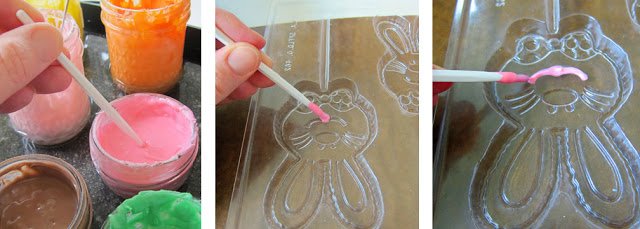
Before you begin creating your hand-painted lollipops, you need to decide what colors you want to use. You will only paint the features of the lollipops, not the background.
For instance, if I want my chocolate Easter bunny to be white, I won't paint anything using white chocolate. I will only paint the features including the smile, eyes, nose, ears, and bow tie on this candy mold.
You can paint all or just some of the features on your mold. For this mold, I skipped painting the whiskers. I think they look fine white.
Paint chocolate into the mold.
Actually, I should say, "dab it" not "paint it."
- Dip a paintbrush into the melted chocolate and dab it into the indentation on the candy mold.
- Add more chocolate to your brush as needed to fill in the entire indented area.
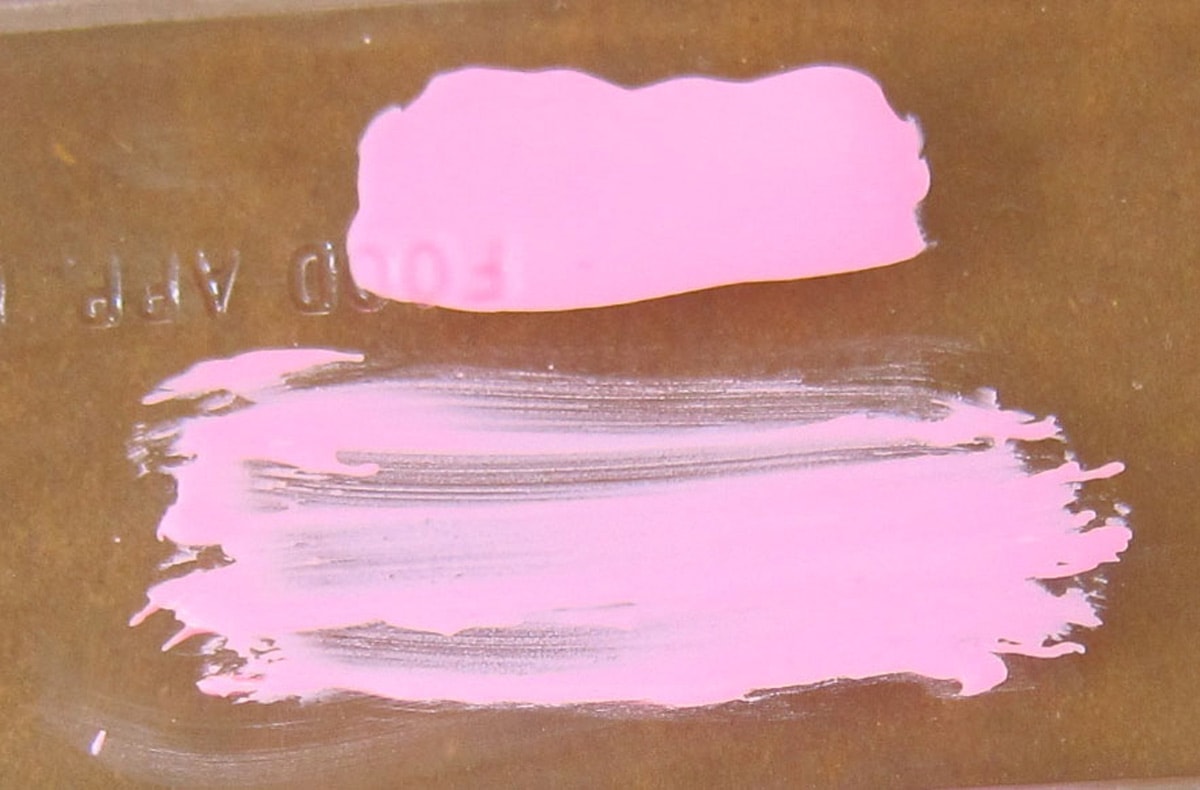
Tips
- By dabbing the chocolate (see the pink spot at the top of the image) you will end up with a nice opaque area.
- If you brush the chocolate on (pink streaks on the bottom of the image), it will harden, streak, and leave you with a see-through area.
- Also, always dip your brush into melted chocolate and not along the sides of the jar, so that you get nicely melted chocolate.
- If you end up with hardened chocolate on your brush, just dip it in the melted chocolate and allow it to sit for a minute to melt away the hardened chocolate from the brush.
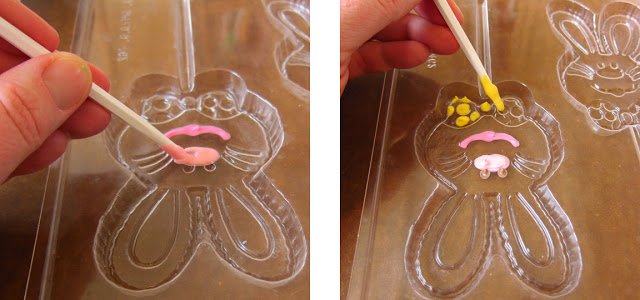
- Use a different paintbrush for each color then paint more details on the candy mold. I used a lighter pink for the bunny's nose and brown for the eyes.
- In order to layer the colors, as I did in the bunny's bow tie, first paint on the yellow polka dots, then put the mold into the freezer for 2-3 minutes to harden the yellow dots.
- Any time you want to create layers of color, start with the color that will be on top, in this case, the polka dots.
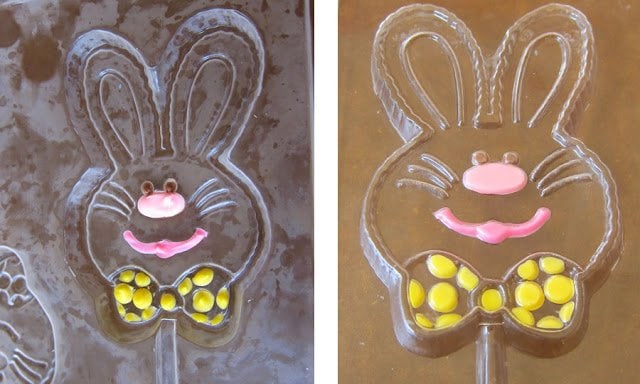
- Then remove the mold and allow it to warm up so that the frost goes away.
- If you start to paint while the mold is too cold, the candy will want to "fly" and stick to other parts of the mold.
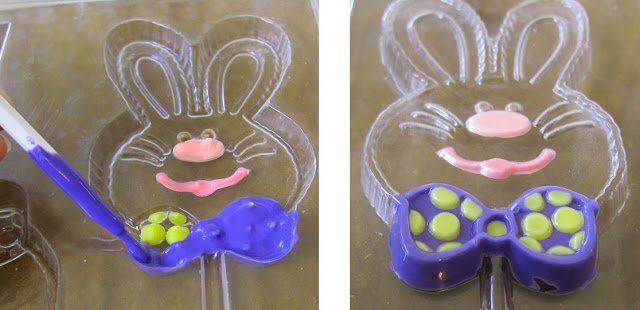
- Then paint the background color directly over top of the other color. I painted purple over top of my yellow polka dots.
- Carefully turn the mold over and look to see if you have covered the entire area. I have a bit of purple yet to paint onto my bow tie (see the lower right side of the bow.) After fixing the bow tie, I painted the ears (not shown) and then put the candy mold back in the freezer for a few minutes.
Tips
- If your painted areas start to dry, get the mold in the freezer right away.
- Darker colors, that air dry, can develop white spots or streaks.

- Before filling the mold, allow the mold to warm up to room temperature.
- Then spoon whatever colored coating you've decided to use for the background into the mold.
- I usually spoon some in, then tap the mold gently on the table, allowing the candy coating to spread and fill in areas like the ears.
- It's best not to overfill the mold, so tap gently as you go. Once the mold is filled, you need to tap it on the table a few times to remove any air bubbles that may have formed.
Tips
Don't fill in the indentation that is for the lollipop stick.
If you do overfill your mold, you can use your finger to wipe off the excess candy or wait until the candy is hardened and you will be able to shave it off with a knife.
Make sure the chocolate you paint or pour over top of your painted features is not too hot! If you add hot chocolate to the mold, the chocolate that is already hardened in the mold will melt and bleed.
If you are dipping your paintbrush into melted chocolate, get it from the top of the jar. If the chocolate gets too close to the heat source in the skillet it may get too hot.
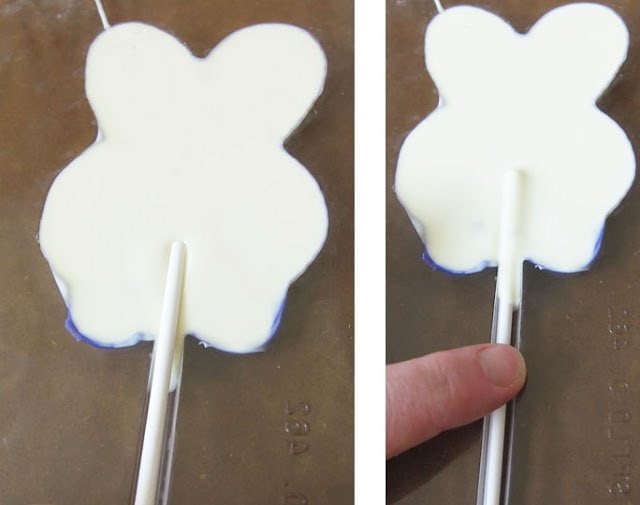
- Add a lollipop stick by setting the stick in the indentation and gently pressing it into the candy.
- Use your finger to roll the stick around so it gets completely coated in the candy.
- Place the lollipop in the freezer for 5-8 minutes. If you are using pure chocolate you'll want to chill your lollipops in the refrigerator.
- It may take a bit longer if you are opening and closing your freezer a lot during the process.
- As the candy coating cools and hardens it will shrink slightly and retract from the mold.
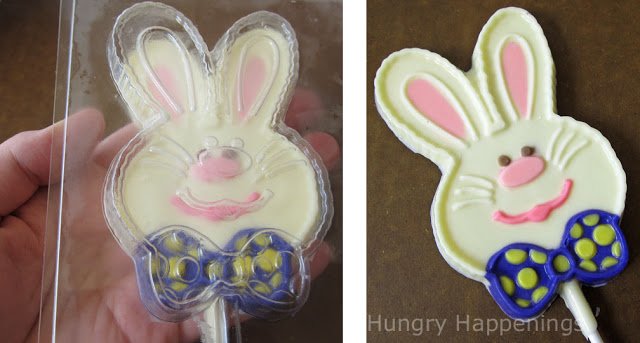
The time it will take for a chocolate lollipop to set up will depend on the size of your candy mold. If you are using compound chocolate (candy melts, melting wafers, almond bark, etc.), you should freeze your lollipops for anywhere between 5 and 15 minutes. If you are using pure chocolate, then you want to refrigerate your lollipops for 5 and 15 minutes.
You can tell if the chocolate or candy melts have completely hardened by carefully holding the mold up over your head, keeping it flat, and checking to see that the candy is one even color. If you see dark spots, that means the candy is still wet in those areas. Freeze or refrigerate the candy for a few minutes longer.
You can also check to see if the lollipops are ready by very gently tugging on the lollipop stick. If the chocolate moves, it should come out of the mold easily. If it sticks, it is not ready. Don't tug too hard, or you may pull a lollipop out before it is completely hardened.
If you are using compound chocolate (candy melts, almond bark, etc.), the chocolate will harden once placed in the freezer.
If you are using pure chocolate, you must have properly tempered the chocolate (heated and cooled it to specific temperatures) in order for it to harden properly.
If you leave your candy in the freezer for too long, beads of condensation will form on the outside, making your lollipops sticky.
Allow the candy to air dry overnight before packaging it.
Gently tug on the stick and pull the candy out of the mold or
place your hand over the candy, turn the mold upside down, and allow the candy to fall out of the mold into your hand, or place a baking sheet over the candy, turn the mold over and the baking sheet upside down allowing the candy to fall out onto the baking sheet.
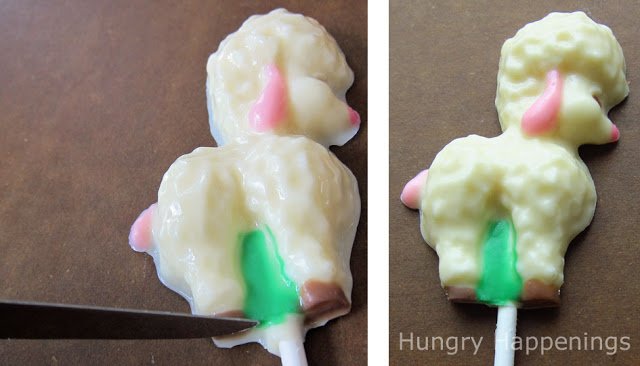
Tips
- If you have overfilled the candy mold and the lollipop has excess candy around the edges, allow the candy to warm up to room temperature. Then use a small knife to carefully cut off the excess candy.
- If you have a lot of excess chocolate and it is very thick, you may want to heat up your knife by running it under really hot water (then drying it) or by holding the knife blade over a flame. Then as you cut off the excess, the knife will melt the chocolate as you go, making it easier to remove.
- Brush off any crumbs using a pastry brush.
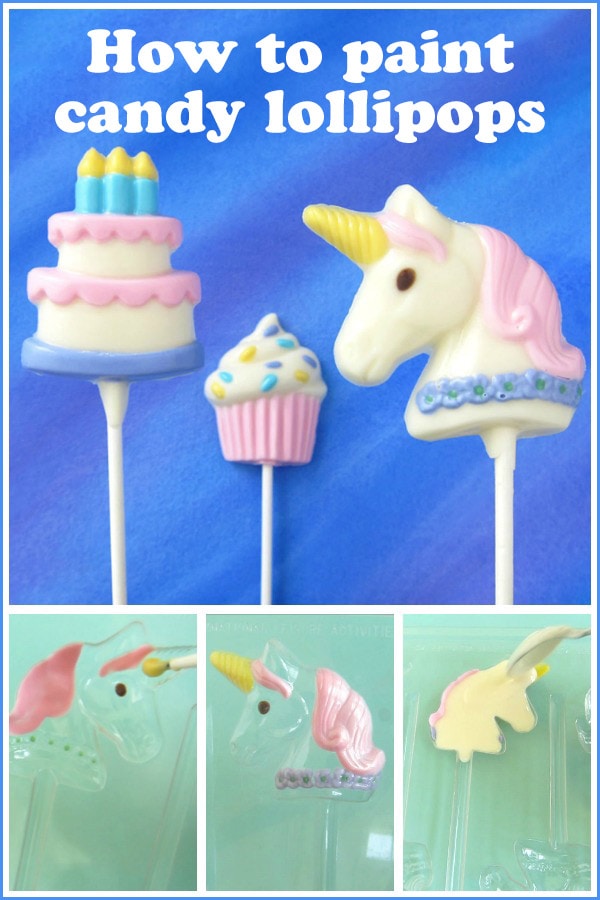
Video
Watch the video to see how to paint your chocolate lollipops. Making homemade chocolate lollipops is so much fun!
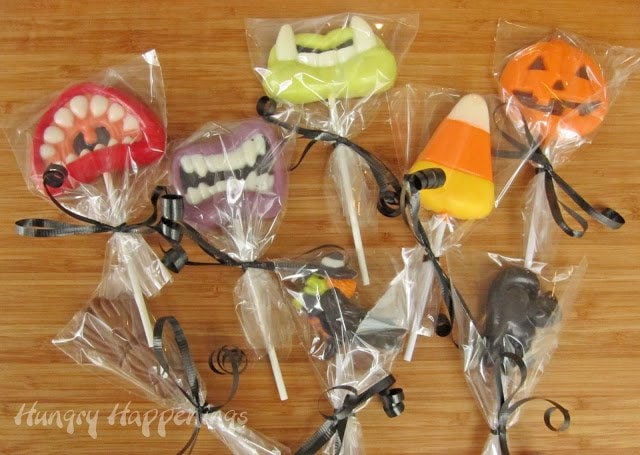
Wrap your lollipops in clear cellophane bags and tie them with a ribbon or twist tie to keep them fresh and looking pretty.
Store the lollipops in an airtight container, at room temperature, away from any strong-smelling products to really enhance their shelf life.
Pure white chocolate lollipops will stay fresh for at least six months if stored at room temperature.
Lollipops made with compound chocolate (confectionery coating, Candy Melts, almond bark, melting wafers, etc.) will be fresh for up to 3 months if stored at room temperature. They will begin to lose some of their flavor after about a month. I can't tell you why this happens, but the sweet vanilla flavor of candy melts (or any confectionery coating) will dull after time.
No, it is best to store chocolate or confectionery coating (candy melts) in the refrigerator or freezer. Just keep the chocolates out of direct sunlight at room temperature.
It's actually not good to store chocolate in really cold temperatures. If you store your candy melts in the refrigerator, condensation will form on the surface, causing your lollipops to get sticky. The beads of sweat may eventually dry but you will have tiny droplets that have dried on your chocolates ruining the nice shiny appearance.
Drastic changes in temperature are even worse with pure chocolate. It causes the cocoa butter to bloom leaving your chocolates with a cloudy, spotty, or streaky appearance.
Tips
- If you color pure white chocolate you must keep it tempered in order to paint it into the candy molds, so the electric skillet method won't work well.
- If you do decide to use pure white chocolate, there is another alternative to coloring the actual white chocolate. Instead, you can paint your molds with melted and colored cocoa butter. You can keep the cocoa butter melted in the electric skillet, but you don't want it to get hotter than 91 degrees Fahrenheit.
- Use the colored cocoa butter to paint the molds. It will dry quickly then you can pour melted and tempered pure chocolate over top. Let that harden, then pop it out of the mold.
More Handpainted Chocolates

You can also use this same chocolate painting technique to make other items like chocolate Easter bunnies, adorable lambs, cute carrots, sweet chicks and more.
If you want to use pure milk or dark chocolate to make your solid chocolate Easter bunnies you can use colored confectionery coating to make your decorations.
Just note that on occasion the confectionery coating and the chocolate won't stick together and the decorations will fall off. I make all my hand-painted chocolate bunnies using this method and I tend to lose noses more than anything else. I just use a dab of chocolate to "glue" the nose back on.
I also will use edible luster dust to add color to my chocolates. You can see the ears on the bunnies at the bottom of the image above are slightly shimmery. They are decorated with luster dust.

There are so many fun projects you can make using colored white chocolate or colored candy melts in addition to painted lollipops. Check out the step-by-step tutorials to make all of these...
Chocolate Caramel Fudge Chicks • Grinch Candy Cups • Sunshine Cookie Pops
Santa Suit Candy Cups • Mickey Mouse Safari Pops • Inside Out Caramel Apples
Candy Corn Cones • Candy Leprechaun Hats • Hollow White Chocolate Chicks
You can also color white chocolate or colored candy melts to make modeling chocolate. Be sure to check out my modeling chocolate recipe and troubleshooting tips page. You might also want to check out my Chocolate Making Courses at The Sugar Academy.
- How to make peanut butter? - February 15, 2024
- OREO Penguins - December 20, 2023
- OREO Snowmen - December 20, 2023

